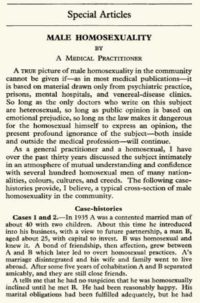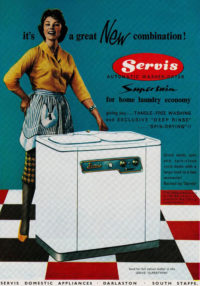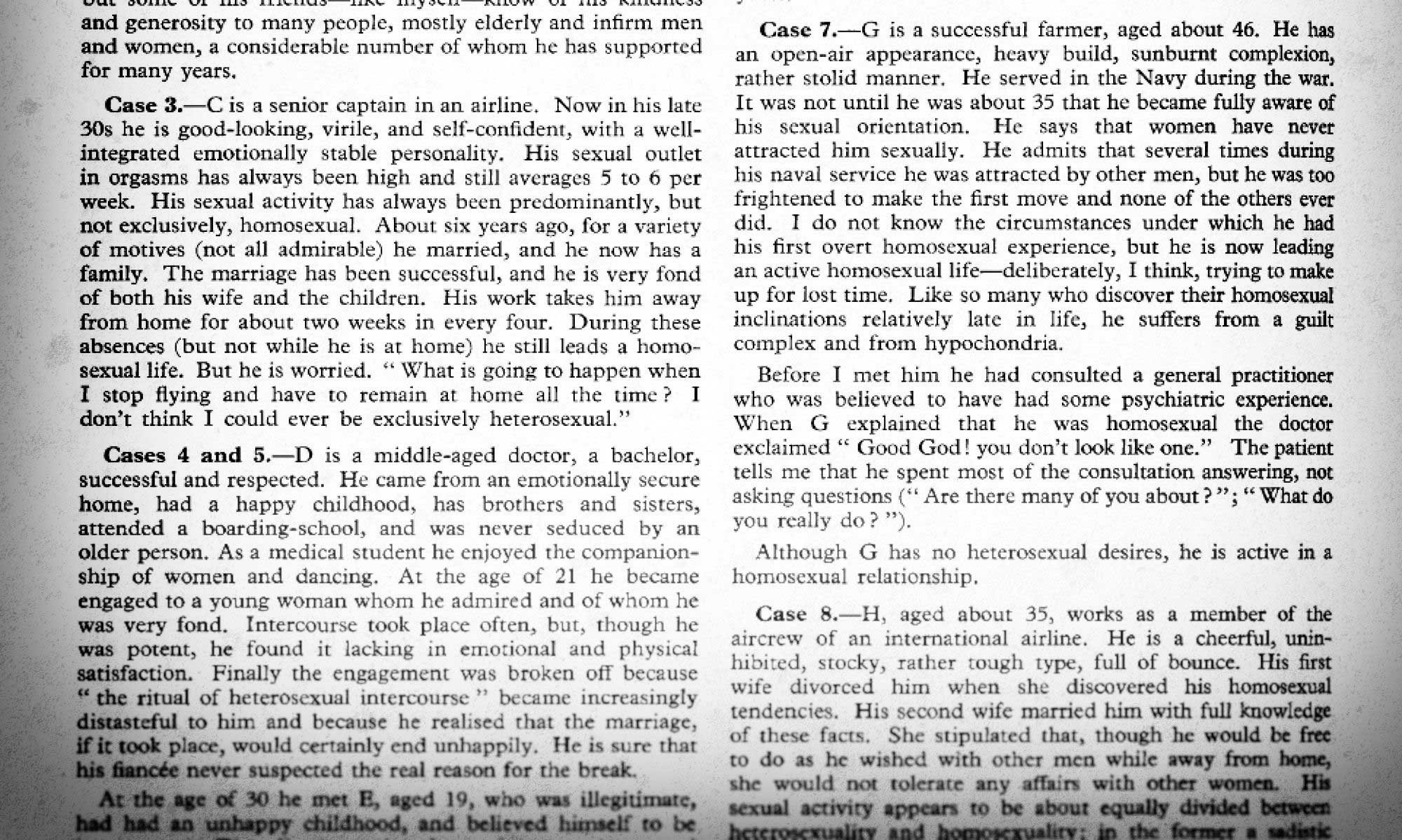In 1957, a British governmental committee chaired by Sir John Wofenden issued its landmark report. The Wolfenden Report recommended that “homosexual behaviour between consenting adults in private be no longer a criminal offence.” One part of the report directly addressed the medical profession: “…homosexuality cannot legitimately be regarded as a disease, because in many cases it is the only symptom and is compatible with full mental health in other respects.”
The report launched a decade of some fairly enlightened discussions about homosexuality in Britain. But those discussions occurred with the Sexual Offences Act of 1885 still on the books. Under that law, a man convicted of “gross indecency” with another man faced up to two years’ imprisonment with hard labor. This law that sent Oscar Wilde to prison and persuaded computer mathematician Alan Turing to accept chemical castration in lieu of incarceration. In addition, the older, more severe law of Buggery still loomed as a possibility, with its possible lifetime sentence. Buggery convictions were much rarer because the standard of proof was much higher, but they still occurred with disturbing regularity. (Lesbian relationships, by the way, have never been illegal in Britain.)
Ater Parliament declined to adopt the Wolfenden proposals in 1958, police took their cue and redoubled their efforts. Arrests and prosecutions for gross indecency rose significantly. Meanwhile, the debate continued, almost all of it by straight people with straight people. It may have been about gay people, but it took place largely without gay people because it was still too dangerous for most gay men to speak up.
Those who did often found ways to do so anonymously. On December 12, 1959, an anonymous doctor — we know him only as “A Medical Practitioner” — did just that through the pages of the prestigious medical journal The Lancet.
If Only We Had More Data
For several years now, The Lancet, and other medical and psychiatric journals like it, were all abuzz about homosexuality and the Wolfenden Report just like everyone else. But these journals tackled this subject like they did every other one: in strictly clinical terms. Articles, filled with charts, graphs, definitions and arcane terminology, tackled homosexuality with the same rigid discipline as those about polio and juvenile diabetes. Researchers plowed through body measurements, hormone levels, sperm counts, psychological and I.Q. test scores, family medical records, school records, and police records, looking for clues to how this condition came about. And then they combed through the results of clinical trials for chemical castrations, hormone injections, electric shock aversion therapy, and other touted treatments in the search for that elusive cure.
As these journals studied homosexuality, they largely steered clear of moral considerations. That was the job of churchmen; these journals were for scientists. And these scientists didn’t really care much about the law either, except to say that, to their scientific way of thinking, the law was obviously the product of medieval thinking and not science. Science, they said, proved that these patients were’t criminals. They were sick. And if this were truly a modern society, it would treat them as such.
The Wolfenden Report tried to challenge that assumption. And occasionally, a doctor here and there wrote in to agree. Homosexuals weren’t sick, they said. This was just a natural variation of human existence, even if they still thought that existence was the result of some kind of conditioning or developmental error. Now, if only there was some data somewhere to prove that…
Out of the Lab and Into the World

But Dr. Practitioner (let’s call him) had an entirely different purpose in mind. He didn’t include a single chart, measurement, or test result in his article. Not one dot or comma came from a laboratory. His tasks required no slide rules, adding machines or graph paper. Instead, he wanted to move the conversation away from clinical observations derived from institutional settings, to challenge his fellow doctors to look at, and listen to, gay men in the real world:
A true picture of male homosexuality in the community cannot be given if — as in most medical publications — it is based on material drawn only from psychiatric practice, prisons, mental hospitals, and venereal-disease clinics. So long as the only doctors who write on this subject are heterosexual, so long as public opinion is based on emotional prejudice, so long as the law makes it dangerous for the homosexual himself to express an opinion, the present profound ignorance of the subject — both inside and outside the medical profession — will continue.
As a general practitioner and a homosexual, I have over the past thirty years discussed the subject intimately in an atmosphere of mutual understanding and confidence with several hundred homosexual men of many nationalities, colours, cultures, and creeds. The following case histories provide, I believe, a typical cross-section of male homosexuality in the community.
His sixteen brief sketches of gay men gave doctors — and us — a marvelous peak into their hidden lives. Their ages ranged from 21 to the mid-80s. Most lived in secret, but some lived their lives out openly. Some had married and later divorced, and some were bisexual and successfully married, more or less. Some were in stable relationships with other men, while others were not so stable. Some were faithful to their wives or partners, others sought discreet affairs, and others still were wildly promiscuous.
They came from all walks of life: doctors, businessmen, an airline pilot, a farmer, an artist. One was a house-husband, of sorts, for his partner. Most appeared relatively well-adjusted, given the circumstances, although two battled depression. Today, we would recognize one of those two as transgender. At the time, gender dysphoria hadn’t yet spoken its name, and just about everyone thought of it as just another way of being homosexual.
“This Is The Only Way I Can Live”
It’s the little details that stand out. “A” didn’t discover his sexuality until age forty. When F was fifteen, his mother warned him that his friends might think he was gay. He replied simply and confidently, “But I am homosexual,” and that was that.
J knew he was gay before he left school. Now in his late thirties, he had recently had sex with a woman who knew about his sexuality. “It was awful,” he said. “It brought me out in a cold sweat… the trouble is that a woman lacks the only thing I find sexually exciting… It was quite hopeless but luckily she understood.”
C, a married airline pilot, played only when when he was away on duty, typically for two to four weeks. Now, he was dreading retirement. “What’s going to happen when I stop flying and have to remain at home all the time? I don’t think I could ever be exclusively heterosexual.”
O, at 48, had been with a man for 28 years. They were contented, monogamous and “do not mix in any homosexuaal coterie,” wrote Dr. Practitioner. “O said to me recently, ‘This is the only way I can live.'” But P’s case was a sad one. Now in his mid-80s, he came from a “socially prominent and prosperous family”:
As he became older he realised that he was predominantly homosexual in orientation, but his family background and training had taught him that this was reprehensible; so he did not allow any homosexual behaviour to occur. He tells me that he never discussed his inclinations with any person until about five years ago when he did so with me. His knowledge of the subject up to that time was derived from reading Greek and other classical writers. It appears that not until after his 50th year did he have his first experience of sexual activity with another person. He is now obsessed by the thought of his “wasted youth”. … He says that if he had had some sexual fulfilment during his youth and maturity he would now be content to “grow old gracefully”.
These sixteen men had very little in common. This was probably by design. It showed the heterogeneous nature of gay men. They also refused to conform to stereotypes. This too, was probably intentional. After all, if one wanted to confirm stereotypes, there were already plenty of well-known examples to turn to. They broke another cliché by never having been in trouble with the law:
None of them has ever been on a police charge for a homosexual offence. None of them knows of any reason why they are homosexually orientated, and all agree that seduction in childhood by older persons was not the cause. I have attended most of them professionally, but none of them consulted me because of homosexuality.
Claims Have Been Made
If any of them had come to him seeking treatment for their sexuality, Dr. Practitioner’s only ethical recourse — and, by extension, that of the rest of the medical profession — would have been to dissuade them from undertaking such a futile effort:
The words ” cure ” and ” treatment ” are used too freely by doctors, judges, magistrates, and lawyers, with little regard to the facts. … Chastity, adopted for moral, religious, or legal reasons or enforced by chemical castration, is not a cure for homosexuality. As far as I am aware homosexually deviated instincts have never been permanently reorientated into heterosexual channels. Claims have been made but none have ever been submitted to the criteria for other medical claims — namely, independent scrutiny and adequate lapse of time to prove permanence. To accept marriage, or an intention to marry, as a criterion of cure is unrealistic.
Another factor often overlooked when cures are claimed is that the homosexual who goes to a psychiatrist for treatment is usually already in trouble with himself (feelings of guilt, depression, or inferiority), with his family (scandal or disgrace), or with the police. He is desperately anxious to be cured and only too glad to accept the psychiatrist’s assurances. Disillusionment comes later.
Dr. Practitioner wrapped up his discussion by criticizing the public’s perceptions about the morality of male homosexuality:
In discussions of homosexuality the physical aspects tend to be overemphasised while the emotional aspects are overlooked. Yet these may be as intense as those experienced by heterosexuals. Many homosexual friendships, like many heterosexual friendships, do not include physical acts. The homosexual liaison — unlike marriage — is unsupported by legal, social, economic, or family considerations tending to encourage permanency. I do not believe that homosexuals are inherently more promiscuous than heterosexuals would be if they had to live under similar conditions of loneliness and sexual insecurity.
Lesbianism, fornication, adultery, rape, even murder can usually be discussed calmly and objectively, but male homosexuality rarely. It seems likely that the illogical and disproportionate emotional reaction produced in some people — usually men, not women — by this subject is caused by unresolved conflicts. It is widely believed among homosexuals that exaggerated revulsion is an indication of latent homosexual tendencies.
Homosexual problems are often the cause of alcoholism and suicide, though the basic reason for these tragedies is rarely disclosed and usually unsuspected.
I make no attempt to defend the immorality disclosed in many of the case-histories, beyond suggesting that it should be judged alongside heterosexual immorality.
On the Timeline:
![]() December 12, 1959: A Gay Doctor Tells Doctors About Gay People.
December 12, 1959: A Gay Doctor Tells Doctors About Gay People.
Periscope:

Headlines for December 12, 1959: Four R.A.F missile bases, armed with about sixty American Thor nuclear missiles, are now in a state of “readiness” and will be declared operational soon. Three thousand Jaguar employees in Coventry are sent home after about 100 workers in the finishing line strike for an additional 6d an hour. Eight trade unions representing cotton weaving mill workers agree to added Saturday morning work for the first time since 1946. U.S. Gen. Nathan Twining drops diplomatic bombshell in blaming French President Charles de Gail for NATO’s weakened military strength. President Dwight D. Eisenhower, during a stop in New Delhi during his world tour, appeals for a “world-wide war against hunger.”
 On the radio: “What Do You Want?” by Adam Faith, “Mack the Knife” by Bobby Darin, “What Do You Want to Make Those Eyes At Me For?” by Emile Ford and the Checkmates, “Travellin’ Light” by Cliff Richard and the Shadows, “Red River Rock” by Johnny and the Hurricanes, “Oh Carol” by Neil Sedaka, “(‘Til) I Kissed You” by the Everly Brothers, “Seven Little Girls Sitting in the Back Seat” by Avons,”Put Your Head On My Shoulder” by Paul Anka, “Teen Beat” by Sandy Nelson, “Snow Coach” by Russ Conway, “Rawhide” by Frankie Laine.
On the radio: “What Do You Want?” by Adam Faith, “Mack the Knife” by Bobby Darin, “What Do You Want to Make Those Eyes At Me For?” by Emile Ford and the Checkmates, “Travellin’ Light” by Cliff Richard and the Shadows, “Red River Rock” by Johnny and the Hurricanes, “Oh Carol” by Neil Sedaka, “(‘Til) I Kissed You” by the Everly Brothers, “Seven Little Girls Sitting in the Back Seat” by Avons,”Put Your Head On My Shoulder” by Paul Anka, “Teen Beat” by Sandy Nelson, “Snow Coach” by Russ Conway, “Rawhide” by Frankie Laine.

On television: Wagon Train (ITV), Sunday Night at the Palladium (ITV), Armchair Theatre (ITV), Emergency Ward 10 (ITV), Concentration (ITV), Take Your Pick (ITV), The Army Game (ITV), Knight Errant (ITV), Juke Box Jury (BBC), Spycatcher (BBC), Bleak House (BBC).
Sources:
Committee on Homosexual Offences and Prostitution. Report of the Committee on Homosexual Offences and Prostitution. (London: Her Majesty’s Stationery Office, 1957): 14, 115. An abridged version of the report is available online here. Part 3 of the report, which deals with prostitution and its related offenses, is not included in this scan.
H. Montgomery Hyde. The Love That Dared Not Speak Its Name: A Candid History of Homosexuality in Britain (Boston: Little, Brown and Company, 1970): 229-256.
A Medical Practitioner. “Male Homosexuality.” The Lancet 274, no. 7111 (December 12, 1959): 1077-1080.
![[Emphasis Mine]](http://jimburroway.com/wp-content/uploads/2018/01/GatewaysClubChelsea1952.jpg)
